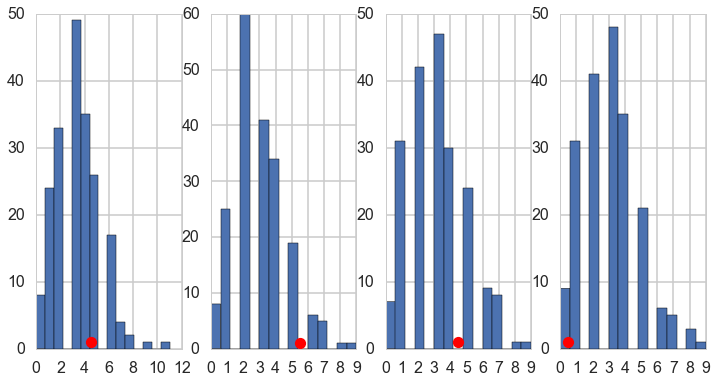Keywords: switchpoint | bayesian | mcmc | mcmc engineering | formal tests | imputation | Download Notebook
Summary
We use a switchpoint model from Fonnesbeck's Bios 8366 course to illustrate both various formal convergence test and data imputation using the posterior predictives
Contents
%matplotlib inline
import numpy as np
import scipy as sp
import matplotlib as mpl
import matplotlib.cm as cm
import matplotlib.pyplot as plt
import pandas as pd
pd.set_option('display.width', 500)
pd.set_option('display.max_columns', 100)
pd.set_option('display.notebook_repr_html', True)
import seaborn as sns
sns.set_style("whitegrid")
sns.set_context("poster")
A switchpoint model
This is a model of coal-mine diasaters in England. Somewhere around 1900, regulation was introduced, and in response, miing became safer. But if we were forensically looking at such data, we would be able to detect such change using a switchpoint model. We’d then have to search for the causality.
Data
disasters_data = np.array([4, 5, 4, 0, 1, 4, 3, 4, 0, 6, 3, 3, 4, 0, 2, 6,
3, 3, 5, 4, 5, 3, 1, 4, 4, 1, 5, 5, 3, 4, 2, 5,
2, 2, 3, 4, 2, 1, 3, 2, 2, 1, 1, 1, 1, 3, 0, 0,
1, 0, 1, 1, 0, 0, 3, 1, 0, 3, 2, 2, 0, 1, 1, 1,
0, 1, 0, 1, 0, 0, 0, 2, 1, 0, 0, 0, 1, 1, 0, 2,
3, 3, 1, 1, 2, 1, 1, 1, 1, 2, 4, 2, 0, 0, 1, 4,
0, 0, 0, 1, 0, 0, 0, 0, 0, 1, 0, 0, 1, 0, 1])
n_years = len(disasters_data)
plt.figure(figsize=(12.5, 3.5))
plt.bar(np.arange(1851, 1962), disasters_data, color="#348ABD")
plt.xlabel("Year")
plt.ylabel("Disasters")
plt.title("UK coal mining disasters, 1851-1962")
plt.xlim(1851, 1962);
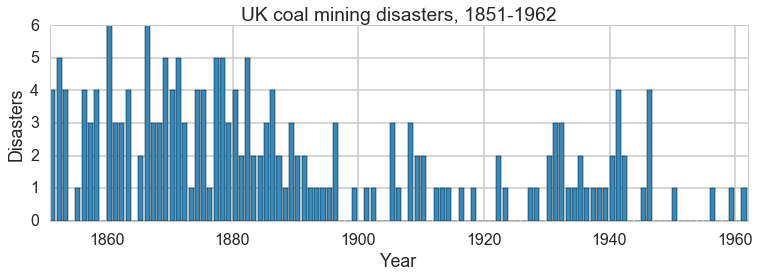
One can see the swtich roughly in the picture above.
Model
We’ll assume a Poisson model for the mine disasters; appropriate because the counts are low.
The rate parameter varies before and after the switchpoint, which itseld has a discrete-uniform prior on it. Rate parameters get exponential priors.
import pymc3 as pm
from pymc3.math import switch
with pm.Model() as coaldis1:
early_mean = pm.Exponential('early_mean', 1)
late_mean = pm.Exponential('late_mean', 1)
switchpoint = pm.DiscreteUniform('switchpoint', lower=0, upper=n_years)
rate = switch(switchpoint >= np.arange(n_years), early_mean, late_mean)
disasters = pm.Poisson('disasters', mu=rate, observed=disasters_data)
Let us interrogate our model about the various parts of it. Notice that our stochastics are logs of the rate params and the switchpoint, while our deterministics are the rate parameters themselves.
coaldis1.vars #stochastics
[early_mean_log_, late_mean_log_, switchpoint]
type(coaldis1['early_mean_log_'])
pymc3.model.FreeRV
coaldis1.deterministics #deterministics
[early_mean, late_mean]
Labelled variables show up in traces, or for predictives. We also list the “likelihood” stochastics.
coaldis1.named_vars
{'disasters': disasters,
'early_mean_log_': early_mean_log_,
'late_mean_log_': late_mean_log_,
'switchpoint': switchpoint}
coaldis1.observed_RVs, type(coaldis1['disasters'])
([disasters], pymc3.model.ObservedRV)
The DAG based structure and notation used in pymc3 and similar software makes no distinction between random variables and data. Everything is a node, and some nodes are conditioned upon. This is reminiscent of the likelihood being considered a function of its parameters. But you can consider it as a function of data with fixed parameters and sample from it.
You can sample from the distributions in pymc3.
plt.hist(switchpoint.random(size=1000));
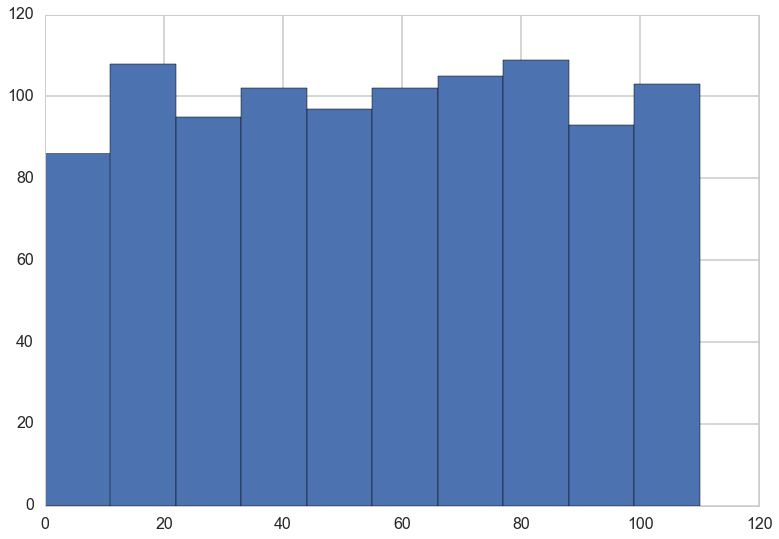
early_mean.transformed, switchpoint.distribution
(early_mean_log_,
<pymc3.distributions.discrete.DiscreteUniform at 0x1188726d8>)
switchpoint.distribution.defaults
['mode']
ed=pm.Exponential.dist(1)
print(type(ed))
ed.random(size=10)
<class 'pymc3.distributions.continuous.Exponential'>
array([ 1.18512233, 2.45533355, 0.04187961, 3.32967837, 0.0268889 ,
0.29723148, 1.30670324, 0.23335826, 0.56203427, 0.15627659])
type(switchpoint), type(early_mean)
(pymc3.model.FreeRV, pymc3.model.TransformedRV)
Most importantly, anything distribution-like must have a logp method. This is what enables calculating the acceptance ratio for sampling:
switchpoint.logp({'switchpoint':55, 'early_mean_log_':1, 'late_mean_log_':1})
array(-4.718498871295094)
Ok, enough talk, lets sample:
with coaldis1:
stepper=pm.Metropolis()
trace = pm.sample(40000, step=stepper)
100%|██████████| 40000/40000 [00:12<00:00, 3326.53it/s] | 229/40000 [00:00<00:17, 2289.39it/s]
t2=trace[4000::5]
pm.traceplot(t2);
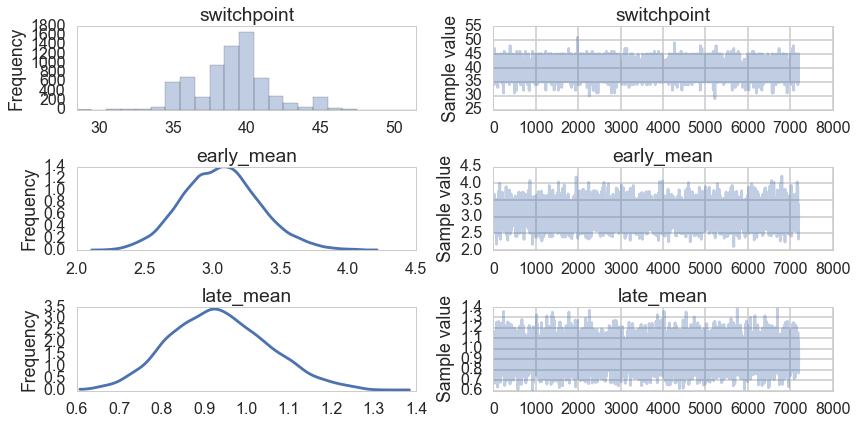
A forestplot gives us 95% credible intervals…
pm.forestplot(t2);
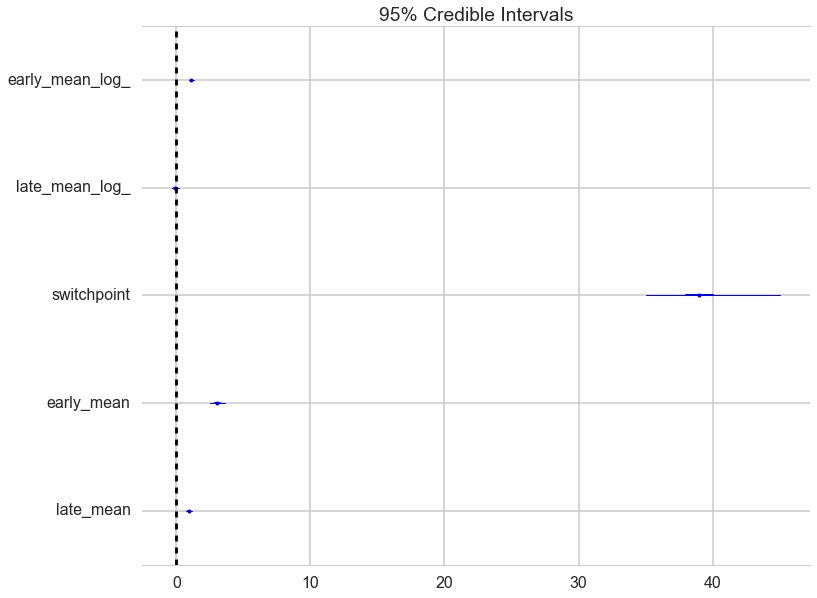
pm.autocorrplot(t2);
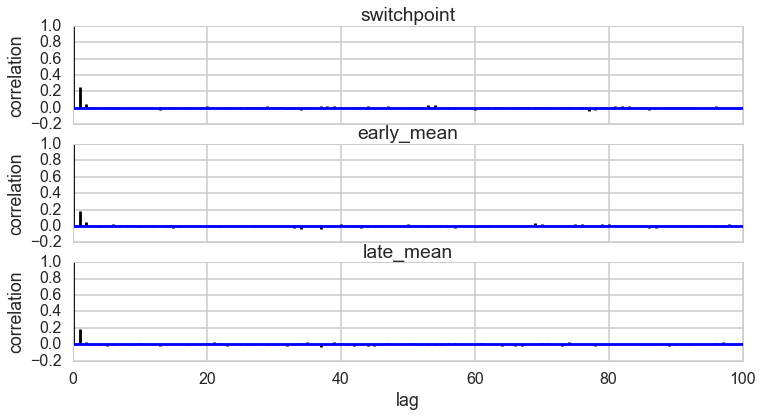
plt.hist(trace['switchpoint']);
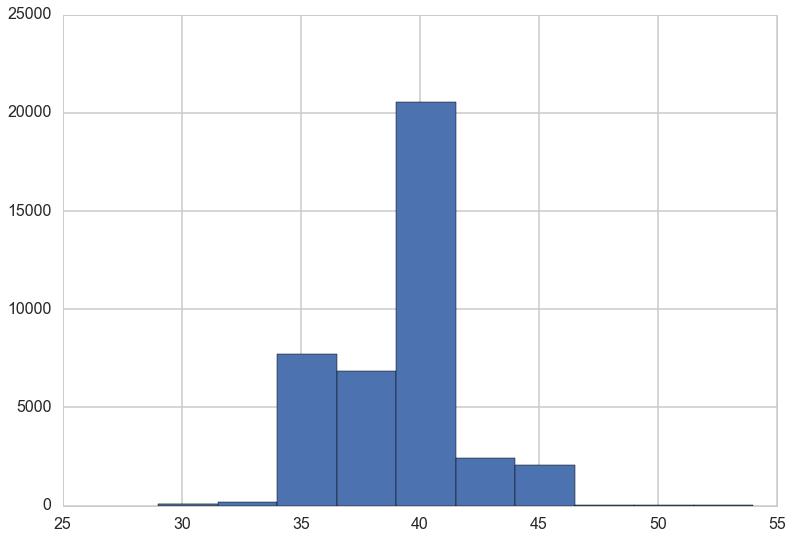
Imputation
Imputation of missing data vaues has a very nice process in Bayesian stats: just sample them from the posterior predictive. There is a very nice process to do this built into pync3..you could abuse this to calculate predictives at arbitrary points. (There is a better way for that, though, using Theano shared variables, so you might want to restrict this process to the situation where you need to impute a few values only).
Below we use -999 to handle mising data:
disasters_missing = np.array([ 4, 5, 4, 0, 1, 4, 3, 4, 0, 6, 3, 3, 4, 0, 2, 6,
3, 3, 5, 4, 5, 3, 1, 4, 4, 1, 5, 5, 3, 4, 2, 5,
2, 2, 3, 4, 2, 1, 3, -999, 2, 1, 1, 1, 1, 3, 0, 0,
1, 0, 1, 1, 0, 0, 3, 1, 0, 3, 2, 2, 0, 1, 1, 1,
0, 1, 0, 1, 0, 0, 0, 2, 1, 0, 0, 0, 1, 1, 0, 2,
3, 3, 1, -999, 2, 1, 1, 1, 1, 2, 4, 2, 0, 0, 1, 4,
0, 0, 0, 1, 0, 0, 0, 0, 0, 1, 0, 0, 1, 0, 1])
disasters_masked = np.ma.masked_values(disasters_missing, value=-999)
disasters_masked
masked_array(data = [4 5 4 0 1 4 3 4 0 6 3 3 4 0 2 6 3 3 5 4 5 3 1 4 4 1 5 5 3 4 2 5 2 2 3 4 2
1 3 -- 2 1 1 1 1 3 0 0 1 0 1 1 1 0 1 0 1 0 0 0 2 1 0 0 0 1 1 0 2 3 3 1 --
2 1 1 1 1 2 4 2 0 0 1 4 0 0 0 1 0 0 0 0 0 1 0 0 1 0 1],
mask = [False False False False False False False False False False False False
False False False False False False False False False False False False
False False False False False False False False False False False False
False False False True False False False False False False False False
False False False False False False False False False False False False
False False False False False False False False False False False False
False False False False False False False False False False False True
False False False False False False False False False False False False
False False False False False False False False False False False False
False False False],
fill_value = -999)
with pm.Model() as missing_data_model:
switchpoint = pm.DiscreteUniform('switchpoint', lower=0, upper=len(disasters_masked))
early_mean = pm.Exponential('early_mean', lam=1.)
late_mean = pm.Exponential('late_mean', lam=1.)
idx = np.arange(len(disasters_masked))
rate = pm.Deterministic('rate', switch(switchpoint >= idx, early_mean, late_mean))
disasters = pm.Poisson('disasters', rate, observed=disasters_masked)
By supplying a masked array to the likelihood part of our model, we ensure that the masked data points show up in our traces:
with missing_data_model:
stepper=pm.Metropolis()
trace_missing = pm.sample(10000, step=stepper)
100%|██████████| 10000/10000 [00:05<00:00, 1973.70it/s] | 39/10000 [00:00<00:25, 389.05it/s]
missing_data_model.vars
[switchpoint, early_mean_log_, late_mean_log_, disasters_missing]
pm.summary(trace_missing, varnames=['disasters_missing'])
disasters_missing:
Mean SD MC Error 95% HPD interval
-------------------------------------------------------------------
2.189 1.825 0.078 [0.000, 6.000]
0.950 0.980 0.028 [0.000, 3.000]
Posterior quantiles:
2.5 25 50 75 97.5
|--------------|==============|==============|--------------|
0.000 1.000 2.000 3.000 6.000
0.000 0.000 1.000 2.000 3.000
pm.traceplot(trace_missing);
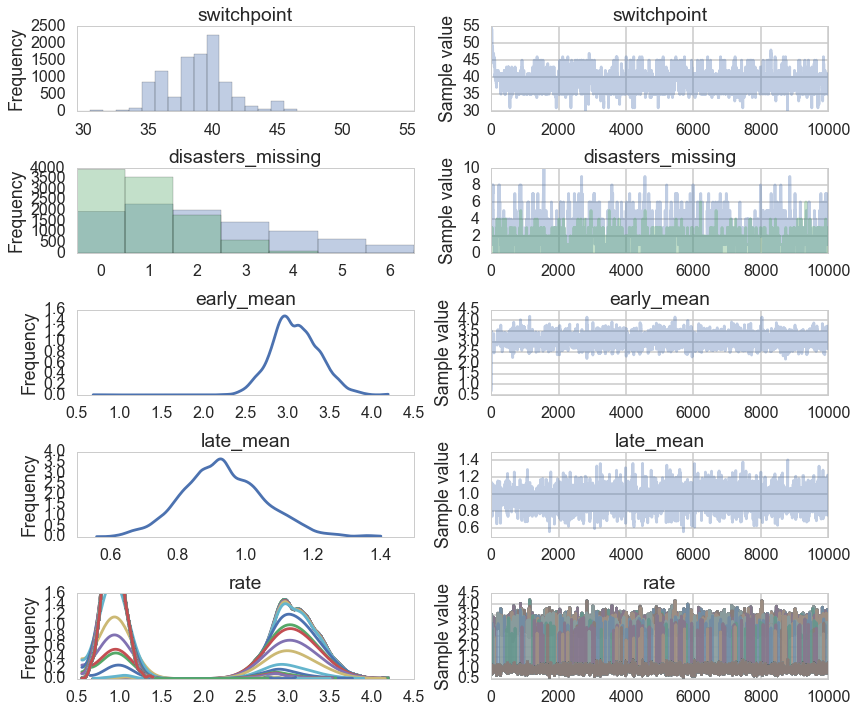
Convergence of our model
Histograms every m samples
As a visual check, we plot histograms or kdeplots every 500 samples and check that they look identical.
import matplotlib.pyplot as plt
emtrace = t2['early_mean']
fig, axes = plt.subplots(2, 5, figsize=(14,6))
axes = axes.ravel()
for i in range(10):
axes[i].hist(emtrace[500*i:500*(i+1)], normed=True, alpha=0.2)
sns.kdeplot(emtrace[500*i:500*(i+1)], ax=axes[i])
plt.tight_layout()
//anaconda/envs/py35/lib/python3.5/site-packages/statsmodels/nonparametric/kdetools.py:20: VisibleDeprecationWarning: using a non-integer number instead of an integer will result in an error in the future
y = X[:m/2+1] + np.r_[0,X[m/2+1:],0]*1j
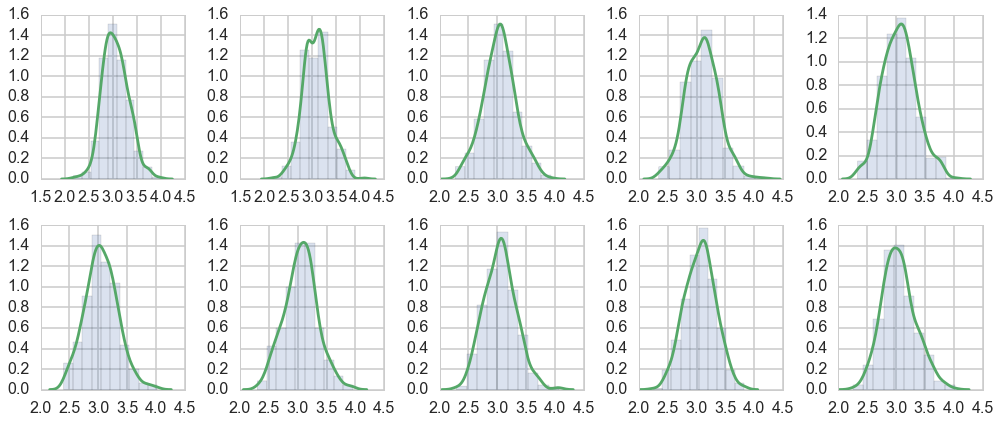
Gewecke test
The gewecke test tests that the difference of means of chain-parts written as a Z-score oscilates between 1 and -1
from pymc3 import geweke
with coaldis1:
stepper=pm.Metropolis()
tr = pm.sample(2000, step=stepper)
z = geweke(tr, intervals=15)
100%|██████████| 2000/2000 [00:00<00:00, 2981.24it/s] | 293/2000 [00:00<00:00, 2929.39it/s]
z
{'early_mean': array([[ 0.00000000e+00, -3.45828523e-01],
[ 7.10000000e+01, 3.06745859e-02],
[ 1.42000000e+02, 5.83423377e-02],
[ 2.13000000e+02, 2.80206667e-02],
[ 2.84000000e+02, 4.96120047e-02],
[ 3.55000000e+02, 6.50698255e-02],
[ 4.26000000e+02, 2.30049912e-02],
[ 4.97000000e+02, 1.79919163e-01],
[ 5.68000000e+02, 3.75965668e-01],
[ 6.39000000e+02, 1.81797410e-01],
[ 7.10000000e+02, 2.83525942e-01],
[ 7.81000000e+02, 4.09588440e-01],
[ 8.52000000e+02, 2.70244597e-01],
[ 9.23000000e+02, -7.98135362e-02],
[ 9.94000000e+02, 1.49024502e-01]]),
'early_mean_log_': array([[ 0.00000000e+00, -3.18705037e-01],
[ 7.10000000e+01, 4.52754131e-02],
[ 1.42000000e+02, 7.11545274e-02],
[ 2.13000000e+02, 4.85507355e-02],
[ 2.84000000e+02, 7.22503145e-02],
[ 3.55000000e+02, 8.10801025e-02],
[ 4.26000000e+02, 3.81296823e-02],
[ 4.97000000e+02, 1.76400242e-01],
[ 5.68000000e+02, 3.67624113e-01],
[ 6.39000000e+02, 1.68373217e-01],
[ 7.10000000e+02, 2.76832177e-01],
[ 7.81000000e+02, 4.17643732e-01],
[ 8.52000000e+02, 2.86557817e-01],
[ 9.23000000e+02, -7.11311749e-02],
[ 9.94000000e+02, 1.72001242e-01]]),
'late_mean': array([[ 0.00000000e+00, -1.16579493e-01],
[ 7.10000000e+01, 1.28540152e-01],
[ 1.42000000e+02, 1.00964967e-01],
[ 2.13000000e+02, 1.33239334e-02],
[ 2.84000000e+02, 7.02284698e-02],
[ 3.55000000e+02, -4.57493917e-02],
[ 4.26000000e+02, -9.54380528e-02],
[ 4.97000000e+02, -3.14319398e-02],
[ 5.68000000e+02, -1.77955790e-01],
[ 6.39000000e+02, -8.84537717e-02],
[ 7.10000000e+02, 1.08046140e-01],
[ 7.81000000e+02, 9.53818953e-02],
[ 8.52000000e+02, 1.33300852e-01],
[ 9.23000000e+02, -9.46580647e-02],
[ 9.94000000e+02, 2.67560286e-02]]),
'late_mean_log_': array([[ 0.00000000e+00, -1.29727449e-01],
[ 7.10000000e+01, 1.26951597e-01],
[ 1.42000000e+02, 9.48433048e-02],
[ 2.13000000e+02, 2.16861379e-02],
[ 2.84000000e+02, 8.52764829e-02],
[ 3.55000000e+02, -4.05677490e-02],
[ 4.26000000e+02, -9.47114742e-02],
[ 4.97000000e+02, -3.16317071e-02],
[ 5.68000000e+02, -1.82386642e-01],
[ 6.39000000e+02, -1.10557422e-01],
[ 7.10000000e+02, 7.26461109e-02],
[ 7.81000000e+02, 4.37389175e-02],
[ 8.52000000e+02, 8.61589551e-02],
[ 9.23000000e+02, -1.20087640e-01],
[ 9.94000000e+02, 1.93212914e-02]]),
'switchpoint': array([[ 0.00000000e+00, 5.65003000e-01],
[ 7.10000000e+01, -1.00652530e-01],
[ 1.42000000e+02, -1.40480998e-01],
[ 2.13000000e+02, -1.79383754e-01],
[ 2.84000000e+02, -1.35196443e-01],
[ 3.55000000e+02, -1.75459073e-01],
[ 4.26000000e+02, -2.76323065e-01],
[ 4.97000000e+02, -2.76484051e-01],
[ 5.68000000e+02, -8.33856119e-03],
[ 6.39000000e+02, -9.93344544e-03],
[ 7.10000000e+02, -1.55557679e-01],
[ 7.81000000e+02, -1.58811057e-01],
[ 8.52000000e+02, 1.53114727e-01],
[ 9.23000000e+02, 3.43833969e-01],
[ 9.94000000e+02, 2.05146360e-01]])}
Here is a plot for early_mean. You sould really be plotting all of these…
plt.scatter(*z['early_mean'].T)
plt.hlines([-1,1], 0, 1000, linestyles='dotted')
plt.xlim(0, 1000)
(0, 1000)
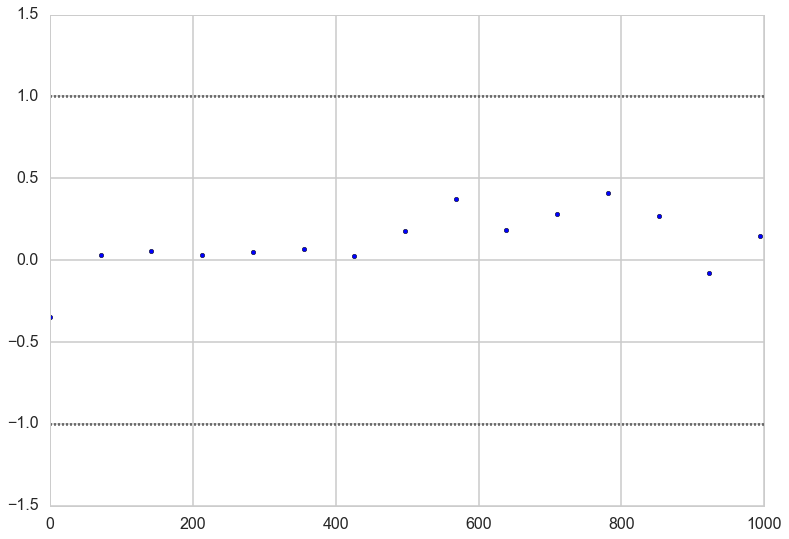
Gelman-Rubin
For this test, which calculates
we need more than 1-chain. This is done through njobs=4. See the trace below:
with coaldis1:
stepper=pm.Metropolis()
tr2 = pm.sample(40000, step=stepper, njobs=4)
100%|██████████| 40000/40000 [00:57<00:00, 696.92it/s] | 1/40000 [00:00<1:26:12, 7.73it/s]
tr2
<MultiTrace: 4 chains, 40000 iterations, 5 variables>
from pymc3 import gelman_rubin
gelman_rubin(tr2)
{'early_mean': 1.0001750040766744,
'early_mean_log_': 1.0001748609698453,
'late_mean': 1.0000180324001593,
'late_mean_log_': 1.0000162848026795,
'switchpoint': 1.0002439960829292}
For the best results, each chain should be initialized to highly dispersed starting values for each stochastic node.
A foresplot will show you the credible-interval consistency of our chains..
from pymc3 import forestplot
forestplot(tr2)
<matplotlib.gridspec.GridSpec at 0x119d390b8>
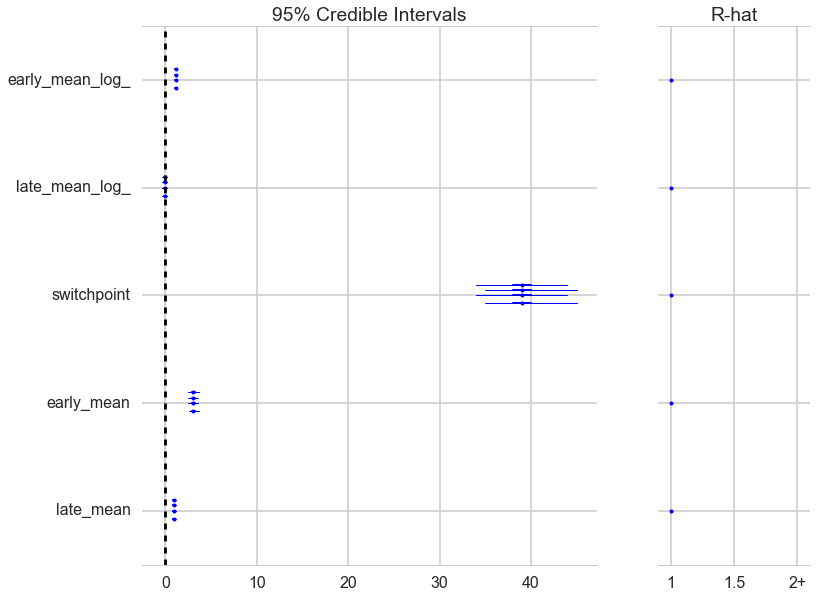
Autocorrelation
This can be probed by plotting the correlation plot and effectibe sample size
from pymc3 import effective_n
effective_n(tr2)
{'early_mean': 16857.0,
'early_mean_log_': 12004.0,
'late_mean': 27344.0,
'late_mean_log_': 27195.0,
'switchpoint': 195.0}
pm.autocorrplot(tr2);
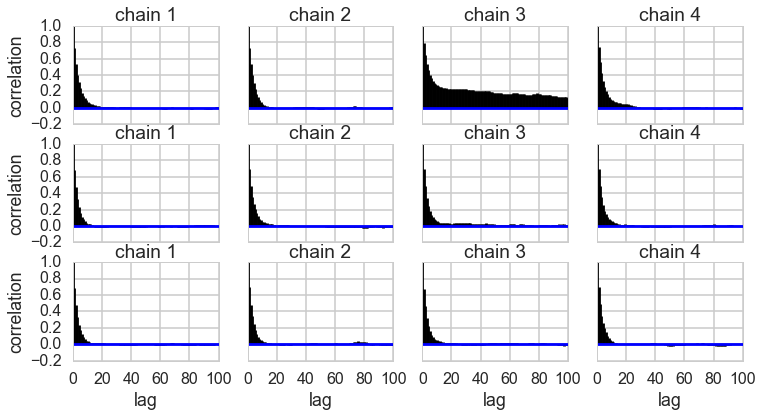
Posterior predictive checks
Finally let us peek into posterior predictive checks: something we’ll talk more about soon.
with coaldis1:
sim = pm.sample_ppc(t2, samples=200)
100%|██████████| 200/200 [00:01<00:00, 137.93it/s] | 10/200 [00:00<00:02, 93.15it/s]
This gives us 200 samples at each of the 111 diasters we have data on.
sim
{'disasters': array([[4, 3, 1, ..., 2, 0, 3],
[3, 2, 5, ..., 1, 4, 0],
[4, 2, 2, ..., 3, 3, 1],
...,
[1, 6, 2, ..., 0, 1, 0],
[3, 3, 0, ..., 2, 0, 0],
[0, 2, 5, ..., 0, 0, 2]])}
We plot the fiest 4 posteriors against actual data for consistency…
fig, axes = plt.subplots(1, 4, figsize=(12, 6))
print(axes.shape)
for obs, s, ax in zip(disasters_data, sim['disasters'].T, axes):
print(obs)
ax.hist(s, bins=15)
ax.plot(obs+0.5, 1, 'ro')
(4,)
4
5
4
0
